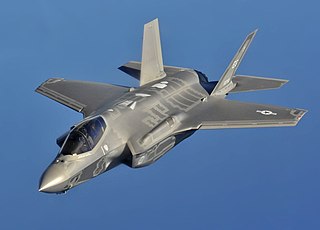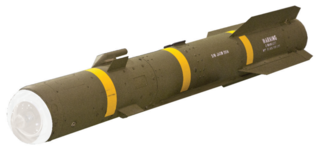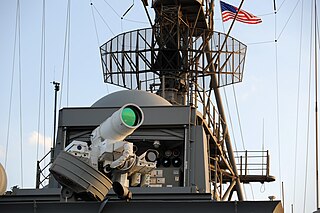Related Research Articles

The Lockheed AC-130 gunship is a heavily armed, long-endurance, ground-attack variant of the C-130 Hercules transport, fixed-wing aircraft. It carries a wide array of ground-attack weapons that are integrated with sophisticated sensors, navigation, and fire-control systems. Unlike other modern military fixed-wing aircraft, the AC-130 relies on visual targeting. Because its large profile and low operating altitudes around 7,000 feet make it an easy target, its close air support missions are usually flown at night.

The Lockheed Martin F-35 Lightning II is an American family of single-seat, single-engine, all-weather stealth multirole combat aircraft that is intended to perform both air superiority and strike missions. It is also able to provide electronic warfare and intelligence, surveillance, and reconnaissance capabilities. Lockheed Martin is the prime F-35 contractor, with principal partners Northrop Grumman and BAE Systems. The aircraft has three main variants: the conventional takeoff and landing (CTOL) F-35A, the short take-off and vertical-landing (STOVL) F-35B, and the carrier-based (CV/CATOBAR) F-35C.

The AGM-114 Hellfire is an air-to-ground missile (AGM) first developed for anti-armor use, later developed for precision drone strikes against other target types, especially high-value targets. It was originally developed under the name Heliborne laser, fire-and-forget missile, which led to the colloquial name "Hellfire" ultimately becoming the missile's formal name. It has a multi-mission, multi-target precision-strike ability and can be launched from multiple air, sea, and ground platforms, including the Predator drone. The Hellfire missile is the primary 100-pound (45 kg) class air-to-ground precision weapon for the armed forces of the United States and many other nations. It has also been fielded on surface platforms in the surface-to-surface and surface-to-air roles.

Paveway is a series of laser-guided bombs (LGBs).

The FGM-148 Javelin, or Advanced Anti-Tank Weapon System-Medium (AAWS-M), is an American-made portable anti-tank missile system in service since 1996, and continuously upgraded. It replaced the M47 Dragon anti-tank missile in US service. Its fire-and-forget design uses automatic infrared guidance that allows the user to seek cover immediately after launch, in contrast to wire-guided systems, like the system used by the Dragon, which require a user to guide the weapon throughout the engagement. The Javelin's high-explosive anti-tank (HEAT) warhead can defeat modern tanks by top attack, hitting them from above, where their armor is thinnest, and is also useful against fortifications in a direct attack flight.

LANTIRN is a combined navigation and targeting pod system for use on the United States Air Force fighter aircraft—the F-15E Strike Eagle and F-16 Fighting Falcon. LANTIRN significantly increases the combat effectiveness of these aircraft, allowing them to fly at low altitudes, at night and under-the-weather to attack ground targets with a variety of precision-guided weapons.

Brimstone is a ground or air-launched ground attack missile developed by MBDA UK for the UK's Royal Air Force. It was originally intended for "fire-and-forget" use against mass formations of enemy armour, using a millimetre wave (mmW) active radar homing seeker to ensure accuracy even against moving targets. Experience in Afghanistan led to the addition of laser guidance in the dual-mode Brimstone missile, allowing a "spotter" to pick out specific and the highest priority targets, particularly useful to minimise collateral damage when friendly forces or civilians were in the area. The tandem shaped-charge warhead is much more effective against modern tanks than older similar weapons such as the AGM-65G Maverick. Three Brimstones are carried on a launcher that occupies a single weapon station, allowing a single aircraft to carry many missiles.

The Lockheed Martin Sniper is a targeting pod for military aircraft that provides positive target identification, autonomous tracking, GPS coordinate generation, and precise weapons guidance from extended standoff ranges.

The MGM-166 LOSAT was a United States anti-tank missile system designed by Lockheed Martin to defeat tanks and other individual targets. Instead of using a high explosive anti-tank (HEAT) warhead like other anti-tank missiles, LOSAT employed a solid steel kinetic energy penetrator to punch through armor. The LOSAT is fairly light; it was designed to be mounted onto a Humvee light military vehicle while allowing the vehicle to remain air-portable. LOSAT eventually emerged on an extended-length heavy-duty Humvee with a hard-top containing four KEMs used by special operations. Although LOSAT never "officially" entered service, it was used for the smaller Compact Kinetic Energy Missile.
The High Energy Liquid Laser Area Defense System (HELLADS), is a counter-RAM system under development that will use a powerful (150 kW) laser to shoot down rockets, missiles, artillery and mortar shells. The initial system will be demonstrated from a static ground-based installation, but in order to eventually be integrated on an aircraft, the final design would require a maximum weight of 750 kg (1,650 lb) and a maximum envelope of 2 cubic meters (70.6 feet3).

The FGM-172 SRAW, also known as the Predator SRAW, was a lightweight, close range missile system produced by Lockheed Martin, developed by Lockheed Martin and Israel Military Industries. It is designed to complement the FGM-148 Javelin anti-tank missile. The Predator had a longer range and was more powerful than the AT4 that it was designed to replace, but had a shorter range than the Javelin.

A laser weapon is a directed-energy weapon based on lasers. After decades of R&D, as of January 2020 directed-energy weapons including lasers are still at the experimental stage and it remains to be seen if or when they will be deployed as practical, high-performance military weapons. Atmospheric thermal blooming has been a major problem, still mostly unsolved, and worsened if fog, smoke, dust, rain, snow, smog, foam, or purposely dispersed obscurant chemicals are present. Essentially, a laser generates a beam of light which needs clear air, or a vacuum, to work without thermal blooming.

The AGR-20 Advanced Precision Kill Weapon System (APKWS) is a design conversion of Hydra 70 unguided rockets with a laser guidance kit to turn them into precision-guided munitions (PGMs). APKWS is approximately one-third the cost and one-third the weight of the current inventory of laser-guided weapons, has a lower yield more suitable for avoiding collateral damage, and takes one quarter of the time for ordnance personnel to load and unload.
The Direct Attack Guided Rocket (DAGR) is a weapons system under development by Lockheed Martin. The program goal is to provide a low cost 2.75 inch (70 mm) precision guided rocket which is compatible with existing Hellfire II systems and launchers in service. The system will use components from the existing Hydra 70 rocket, but differs from other upgrades to the Hydra 70 such as APKWS and LOGIR in that it is designed to be plug and play compatible with the Hellfire missile and use the M299 Hellfire launcher, increasing the load-out by up to four times. DAGR also offers a lock-on before launch capability that is not compatible with the electronics in existing Hydra 70 launchers.

The AGM-179 Joint Air-to-Ground Missile (JAGM) is an American military program to develop an air-to-surface missile to replace the current air-launched BGM-71 TOW, AGM-114 Hellfire, and AGM-65 Maverick missiles. The U.S. Army, Navy, and Marine Corps plan to buy thousands of JAGMs.

A precision-guided munition is a guided munition intended to precisely hit a specific target, to minimize collateral damage and increase lethality against intended targets. During the First Gulf War guided munitions accounted for only 9% of weapons fired, but accounted for 75% of all successful hits. Despite guided weapons generally being used on more difficult targets, they were still 35 times more likely to destroy their targets per weapon dropped.

The AGM-158C LRASM is a stealthy anti-ship cruise missile developed for the United States Air Force and United States Navy by the Defense Advanced Research Projects Agency (DARPA). The LRASM was intended to pioneer more sophisticated autonomous targeting capabilities than the U.S. Navy's current Harpoon anti-ship missile, which has been in service since 1977.

The GBU-39/B Small Diameter Bomb (SDB) is a 250 lb (113 kg) precision-guided glide bomb that is intended to provide aircraft with the ability to carry a higher number of more accurate bombs. Most US Air Force aircraft will be able to carry a pack of four SDBs in place of a single 2,000 lb (907 kg) bomb.

The AN/SEQ-3 Laser Weapon System or XN-1 LaWS is a laser weapon developed by the United States Navy. The weapon was installed on USS Ponce for field testing in 2014. In December 2014, the United States Navy reported that the LaWS system worked perfectly against low-end asymmetric threats, and that the commander of Ponce was authorized to use the system as a defensive weapon.

The Lockheed Martin SR-72, colloquially referred to as "Son of Blackbird", is an American hypersonic UAV concept intended for intelligence, surveillance and reconnaissance (ISR) proposed privately in 2013 by Lockheed Martin as a successor to the retired Lockheed SR-71 Blackbird. The company expected an SR-72 test vehicle could fly by 2025.
References
- ↑ Johnathan Skillings (May 8, 2013). "Lockheed laser weapon hits its mark again". CNET. Retrieved 2013-05-09.
- ↑ "Lockheed Martin Demonstrates Adam Ground-Based Laser System Against Military-Grade Small Boats · Lockheed Martin". Archived from the original on 2017-04-21. Retrieved 2017-04-02.